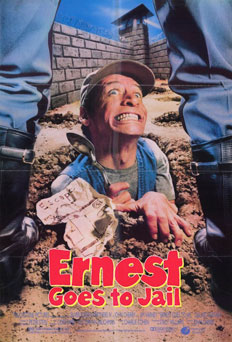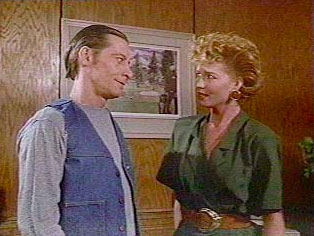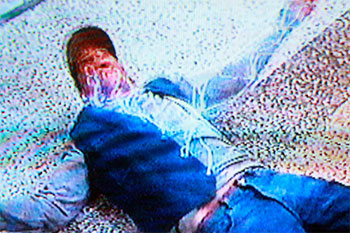Hey, look! It’s our first user submitted article! Many thanks to those who’ve submitted articles already; and to those who haven’t yet, what’s taking you so long? We can’t tell you how excited we’ve been to read these when we check our mail. After all, we’re trying to rescue memories from obscurity here, and you probably remember a lot of things we don’t. Also, it doesn’t hurt that user submissions mean we can be lazy and let you do all the work. So, if you’ve ever had a moment of clarity and remembered something you’d long since forgotten, jot it down and send it our way.
…and then tell 50 of your friends about the site.
What Was His Crime? Being Too Wonderful.
By Johnny Pomatto
There was an all too brief time when Jim Varney’s Ernest P. Worrell was a cultural icon. At first he was limited to State Fair appearances and car dealership commercials, but somewhere along the way, he became the star of four successful theatrical films, and later, five direct to video follow-ups. I’ve taken to regularly asking my friends which is their favorite Ernest movie. I get a lot of “Ernest Goes To Camp,” and a few misguided bastards who defend “Saves Christmas” and “Scared Stupid.” But very rarely do I hear people mention what is far and away Varney’s greatest film.

“Ernest Goes To Jail” is the most classically influenced Ernest film to date. His role of a night janitor in a bank hearkens back to memories of W.C. Fields in “The Bank Dick.” The bank itself offers an exciting set piece and the opening scene in which Ernest becomes electromagnetic is inventive and exciting, as Ernest is attacked by filing cabinets, staplers, and safety deposit boxes. It is a completely original scene, not featured in a film before or since. The film also includes another wonderfully hilarious sequence in which Ernest starts to chew on a pen, only to have it explode, covering his mouth and face in black ink.
So far, so good, but how is sweet, simple-minded Ernest going to get to jail? We keep seeing ominous scenes of a prisoner known only as Mr. Nash. We always just see him from behind. Who is this mysterious stranger and what could he possibly have to do with the A story? It isn’t until Ernest is hilariously and proudly serving his civic duty on a jury when we learn that Ernest is the exact double of Mr. Nash. That’s right. In a move that can only be described as Shakespearean, Jim Varney plays a dual role!
Now it would have been easy for him to play a really funny villain, but he doesn’t. Mr. Nash is an evil, murdering, hardened criminal. A nice stretch for Varney. This adds a real sense of suspense and danger once Nash is out and disguised as Ernest. In his attempts to rob the bank that Ernest works for, we never know if he’s going to kill one of Ernest’s friends Chuck and Bobby, (the hilarious and expressive team of Gailard Sartain and Bill Byrge, reprising their roles from most of Ernest’s other films), or even rape his potential girlfriend. It is the Mr. Nash scenes that confirm this to be Varney’s greatest and most layered performance.

The set piece of the prison is also delightfully surreal. It’s not the least bit realistic but rather is washed in nightmarish colors of purples, pinks, and greens. Ernest’s prison uniform magically becomes an inmate-green version of his signature costume. The prison guards are dressed in cartoony broad shouldered uniforms. Every scene in the prison feels more like a dream sequence that Ernest might wake up from at any minute… but of course he never does.

Most of the humor is derived from Ernest’s many escape attempts, including one in which he dresses up as his famous alter-ego, Auntie Nelda. It is also in jail where seemingly just for fun, he stands in front of the mirror and does a spot on James Mason impression. Now people write off Ernest as a character geared towards children and rednecks, but clearly Mr. Varney’s cultural horizons expand far beyond that, plucking out an impression of an actor that most children have never even heard of. In fact, you won’t find a single child in the whole film. How refreshing that we are able to watch adults do stupid comedy, without having children present to announce to the audience that this is indeed a family comedy. This notion would already be completely abandoned by the time “Ernest Scared Stupid” came around, with Ernest and a bunch of kids working together to stop a troll. At that point, he was just paving the way for his Saturday morning variety show.
This still is a movie for kids, though it does go into truly dark territory at the end when Mr. Nash, (though really Ernest), is sentenced to death by the electric chair. These are high stakes, people. The threat is real here, and the danger is thrilling to the point that we actually see Ernest sitting down in the chair, about to die. Of course he does not, but the switch is pulled, with the executioner showing little remorse in his eagerness to kill our beloved, redneck icon. Due to his magnetized state from the beginning of the film, the electricity doesn’t kill Ernest, but rather turns him into Ernest P. Worell: Electro-Man, giving him the power to shoot lighting from his hands. If the film was starting to lose anyone, this is the point where it wins us back.

Ernest goes on a rampage and successfully escapes from prison just in time to attempt to stop Nash from robbing the bank and blowing up his girlfriend. However the electric powers fade away, but new powers arise. Suddenly he is given the ability to be weightless and Ernest begins to bounce around in zero gravity. Between this and the Electro-Man scenes, this is the first introduction of magical-realism in the Ernest universe. It’s like Calderon’s “Life is a Dream” with toilet-plunger jokes.
After a spectacular finale of Ernest fighting Nash and flying around the bank, he flies the bomb high into the air and seemingly explodes. As everyone is mourning Ernest’s death and hailing him as a hero, Ernest falls down to earth and utters the immortal phrase, “I came, I saw, I got blowed up.” Truer words were never spoken. Most films would have some sort of a coda or an epilogue. Not this one. Funny line, face-first fall, and roll credits. Any more of a wrap up would just be filler, but we do get the nice moral lesson a little earlier when Ernest gives his cellmate friend a chance to escape and he refuses. The probable violent offender (and likely racist) states that he belongs in prison and that at the end of the day, prison is a pretty nice place for a guy like him.
This would be the last truly great Ernest movie, though the direct to video “Ernest Rides Again” comes close. After that it would all be visits to Africa and chance encounters with Kareem Abdul-Jabbar. Sure, his adventure at camp is pretty good, but I think you’ll now agree that this film truly pushed boundaries, at least as much as an Ernest movie can. “Know what I mean?”

Remember Ernest Goes to Jail ?
